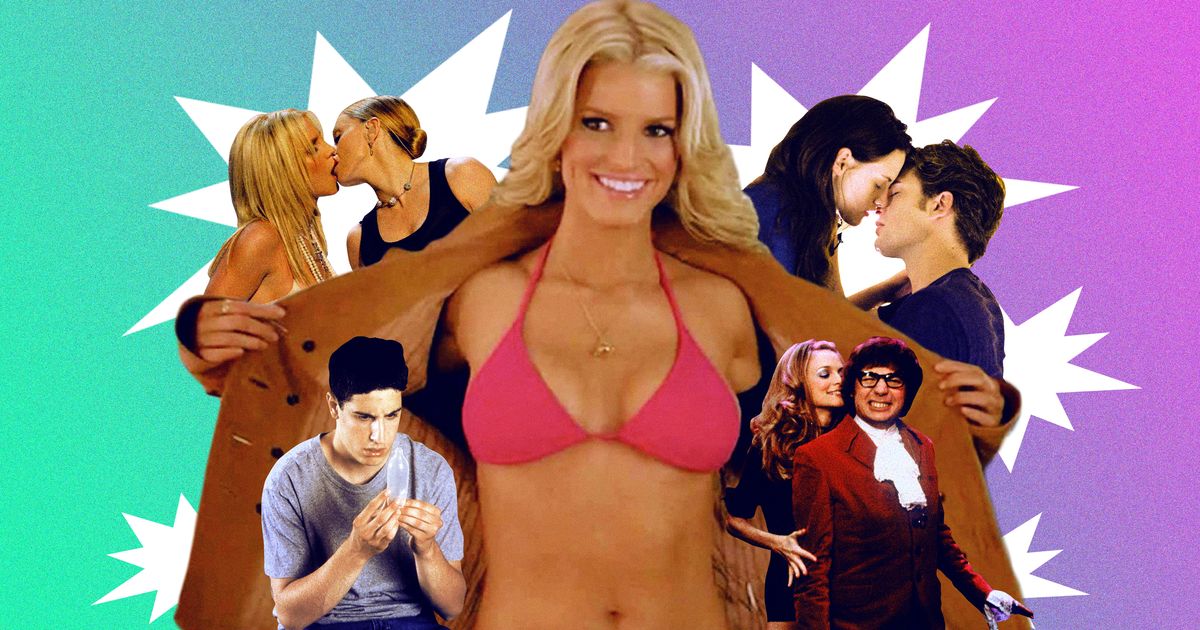
The Horniest Decade: A Taxonomy
During the 2000s, pop culture’s depictions of sex tended toward goofy, as if Hollywood had been run by teenage boys with cartoon eyes popping out of their skulls and mile-long tongues hanging out of their mouths. The sheer horniness of the aughts was unique from other eras in its total lack of subtlety, distinctly raunchy in a way that has fallen out of vogue. Think: Axe commercials where women want to have sex with you at the grocery store, buddy comedies about taking a road trip to lose your virginity, Maxim covers teasing a list of the best outdoor gear with the tagline “Spank Mother Nature!” Women sported low-rise pants and high-rise thongs, and men wore trucker hats that suggested careers in adult film.
Sex still sells, of course, but it’s packaged in self-awareness, layered with years of internet discourse about consent and kink and modern intimacy. Shows like Normal People are lauded for their “realistic” sex scenes — slow to start, sometimes nervous, and free from cinematic orgasms. Euphoria takes the opposite approach with flashy soft-core cinema, Skinemax with an HBO budget. Both shows employ intimacy coordinators, whom directors routinely bring in to protect actors “doing hyper-exposed work.”
The decline of early-aughts horny culture can be attributed to a few main developments. It was a slow death, brought forth in part by the internet’s tightening grip on our personal lives and the media’s recognition of women as … people. As porn and porn-adjacent content became available at the tap of a touchscreen (Pornhub launched in 2007, Instagram in 2010), sex bled into pop culture with less frequency. Today, sex is dispersed across the web. Everyone can have their own personalized, algorithmically curated e-stash.
The bygone era, which for the purpose of this list will be referred to as Horny Culture, was tainted by exploitation, and it’s worth exploring how we got there and how we got out. The following list is a taxonomy of the aughts’ horniest pop-culture moments, forgotten formative memories, the Cosmo tips that are forever burned into our brains. (You can measure your boob size by comparing them to fruit; Katy Perry allegedly has C-cups, or, grapefruits.) This list is an exercise in horny anthropology, an attempt to establish the 2000s Horny Culture canon — the good, the (mostly) bad, and the absurd.
Fashion
Bratz Dolls
Years before Kylie Jenner tightened and plumped her face to resemble that of a sexy alien cub, Bratz dolls were drawing the Instagram Face blueprint. Their tiny noses, huge glossy lips, and bedroom eyes mirror the rhinoplasties, fillers, and premature face-lifts that have become commonplace among models, influencers, and airbrushed regulars. (Footless legs and detachable shoes have yet to make it into mainstream pop culture.)
In 2005, four years after Bratz launched, global sales were $2 billion. By 2006, Bratz had roughly 40 percent of the fashion-doll market. Yes, “the girls with the passion for fashion” caused quite a stir in good ways and bad. Parents expressed concern over the dolls’ oversexualized look and unrealistic body proportions. They weren’t wrong, but they were admitting to feeling sexually confused about a ten-inch plastic doll, and that is a testament to Bratz’s role in horny-culture history.
American Apparel
If you lived in a major city or frequented the “hipster” corners of the internet (Carles, r u there?) in the 2000s, you’ll remember that the American Apparel girls were everywhere. You could see them on billboards, wheat-pasted to construction sites, printed on the back cover of Vice magazine. The girls wore next to nothing, presumably to accentuate the one thing that they were wearing, like thigh-high tube socks or a see-through bra or a crop top emblazoned with the words “Legalize L.A.” Some of the ads included brief bios of the models that read like a dating profile or a trading card or a blurb for a back-page escort service. They had names like Dana and Steffi. Most of the American Apparel girls were relative unknowns, and the company prided itself on casting “regular” people in its campaigns, though the porn actress Lauren Phoenix posed for one especially memorable ad.


Photo: New York Post
A splashy 2004 cover of Us magazine declared “Teens Gone Wild!” over three grinning starlets— Hillary Duff, Lindsay Lohan, and Mischa Barton. “Older men, all-night partying, extreme PDA.” The women appear more “school-picture day” than the copy might lead you to believe. But the cover is designed to look … familiar, resembling a different kind of magazine, DVD, or old VHS tape. In November 2006, the front page of the New York Post featured a photo of Lindsay, Britney, and Paris in the front seat of a car, looking high on nightlife (among other things), their eyes vacant. The headline reads, in bold impact font, “BIMBO SUMMIT.” These were the original influencers.
When Britney was filmed shaving her head and smashing a pap’s car window with an umbrella in 2007, the tabloid era began to shatter. Things got dark as the depths of the psychological damage done by daily harassment of these young stars came to light. Keeping Up With the Kardashians aired that year, when Kim was best known for being friends with Paris Hilton — an occasional guest in her paparazzi shots — and a victim of a leaked sex tape scandal. A new reign began.
Related
- 10 Heartbreaking Details From Jessica Simpson’s Memoir, Open Book
- The Weird Sadness of Aughts Nostalgia
- Failing Britney Spears
























































